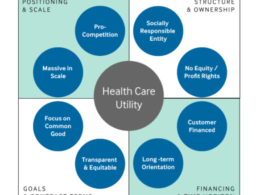This is a republication of an excerpt of the article “Digital transformation: Clinician burden or benefit?”, published by Darryl Gibbings-Isaac, on APRIL 8, 2022, with the title above, preceded by an Executive Summary
One page summary by:
Joaquim Cardoso MSc.
Health Transformation — Research and Advisory Institute
Digital Health Unit
July 15, 2022
What is the problem?
- Digital transformation isn’t always meeting clinician expectations-and many perceive it as completed when it is actually an ongoing journey that never stops (This are the results from surveying more than 350 clinicians across the globe as part of the 2022 State of Healthcare Report)
- More than half of US clinicians are saying transformation is happening faster than they expected. While it’s good news that 45% say their transformation is at the advanced stage of implementation, the feedback we received was not all positive.
- Sixty-nine percent say the transformation contributed to greater work-related stress and 49% say it increased burden and wasted their time.
What is the paradox?
- The paradox here is that for an almost equally large percentage-61% report it’s helping health organizations and increasing productivity within the organization.
- This isn’t the zero-sum game it could look like as encouragingly, healthcare organizations right now are making improvements in the digital work environment based on clinicians’ feedback, according to 68% of US clinicians.
What are the main barriers for successful digital transformation?
A vast majority of US clinicians (9 in 10) see several barriers:
- 32% cited lack of clear communication within the health organization
- 32% cited a lack of proper training
- 37% thought that the digital tools introduced do not fit in clinical workflows
What are the solutions?
The tools they want to use are ones in support of their patients.
- For instance, 43% choose to use digital technologies to support or augment clinical decision making.
- Another 43% cited wearable monitoring devices (e.g., consumer device like an Apple Watch) that provide information that they wouldn’t otherwise have access to.
- And 37% cited virtual health tools so that they could meet patients where they are.
Clinicians also believe that in some service areas, patient needs can be better addressed with digitally enabled care, particularly those aspects that help patients engage when they aren’t in the room.
- These include ongoing disease management (70%),
- coordination of care (64%) and
- preventative care and screenings (60%).
Ultimately, the successful adoption of digital tools to enable the delivery of personalized care at scale is going to rest on the success of digital transformation overall.
- 1.Fight the friction
- 2. Offer the right incentives
- 3. Make continuous improvement part of transformation
ORIGINAL PUBLICATION (excerpt of the full version)

Digital transformation isn’t always meeting clinician expectations-and many perceive it as completed when it is actually an ongoing journey that never stops.
This are the results from surveying more than 350 clinicians across the globe as part of the 2022 State of Healthcare Report.
More than half of US clinicians are saying transformation is happening faster than they expected.
While it’s good news that 45% say their transformation is at the advanced stage of implementation, the feedback we received was not all positive.
Sixty-nine percent say the transformation contributed to greater work-related stress and 49% say it increased burden and wasted their time.
More than half of US clinicians are saying transformation is happening faster than they expected.
While it’s good news …Sixty-nine percent say the transformation contributed to greater work-related stress and 49% say it increased burden and wasted their time.
The paradox here is that for an almost equally large percentage-61% report it’s helping health organizations and increasing productivity within the organization.
This isn’t the zero-sum game it could look like as encouragingly, healthcare organizations right now are making improvements in the digital work environment based on clinicians’ feedback, according to 68% of US clinicians.
Ideally, we will reach a stage where digital transformation meets both the expectations of the healthcare organization and clinicians in their daily practice, which is important as digital deployment is an evolving journey. To do that, we first must understand what’s getting in the way.

Breaking down the digital barriers
When we looked at what might be getting in the way of successful digital transformation, we learned that a vast majority of US clinicians (9 in 10) see several barriers:
- 32% cited lack of clear communication within the health organization
- 32% cited a lack of proper training
- 37% thought that the digital tools introduced do not fit in clinical workflows
37% thought that the digital tools introduced do not fit in clinical workflows
The good news is that these barriers can be addressed.
Even better news is that despite some of the friction, there are digital tools that are bringing clinicians value and they are choosing to use them regardless of whether they are required.
The tools they want to use are ones in support of their patients.
- For instance, 43% choose to use digital technologies to support or augment clinical decision making.
- Another 43% cited wearable monitoring devices (e.g., consumer device like an Apple Watch) that provide information that they wouldn’t otherwise have access to.
- And 37% cited virtual health tools so that they could meet patients where they are.
Clinicians also believe that in some service areas, patient needs can be better addressed with digitally enabled care, particularly those aspects that help patients engage when they aren’t in the room.
- These include ongoing disease management (70%),
- coordination of care (64%) and
- preventative care and screenings (60%).
Clearly, digital transformation benefits clinicians, patients and healthcare organizations. If we make it even more beneficial and accessible, the rewards will increase exponentially.

Transformation is a journey, not a destination
Ultimately, the successful adoption of digital tools to enable the delivery of personalized care at scale is going to rest on the success of digital transformation overall.
The leaders within healthcare organizations can improve adoption of digital tools by putting clinicians, as well as patients, at the center of digital transformation and help them see this process as one that is ongoing.
The leaders within healthcare organizations can improve adoption of digital tools by putting clinicians, as well as patients, at the center of digital transformation and help them see this process as one that is ongoing.
Here’s how:
- 1.Fight the friction
- 2. Offer the right incentives
- 3. Make continuous improvement part of transformation
1.Fight the friction:
Our research revealed that clinicians are facing stress and they feel the burden of digital transformation.
Leaders can change this sentiment by involving clinicians in determining the right digital tools that will save time, help them serve patients better and fit into existing clinical workflows.
But how should organizations get clinicians involved? The most important thing to do is get their feedback early.
It’s much easier to listen to their thoughts and concerns at the prototype phase and initial design, rather than once tools are already developed or deployed.
Establish a feedback mechanism and apply it to every new digital innovation. I’ve seen this work well in the medical device realm.
When clinicians have input into what will work well for patients and fit into their clinical workflows, there is greater opportunity for successful adoption.
2. Offer the right incentives
Reimbursement schemes and incentives from health organizations haven’t been top motivators for clinicians to deliver personalized care.
Health organizations can look for ways to make digital transformation a more appealing proposition.
For instance, payments and benefits can be optimized to promote digitally enabled and personalized care.
It’s also important to consider the non-financial incentives.
Would adoption of certain digital innovations help boost a clinician’s reputation, elevate quality scores or help improve standards of care?
Clinicians we surveyed are saying they aren’t properly incentivized, so it’s time to change that.
3. Make continuous improvement part of transformation
It was surprising to learn that so many clinicians feel their organizations have completed digital transformation.
I know it’s not a one and done. Digital transformation is ongoing and when done right, there will be a continuous feedback loop that includes a defined process to quickly review and implement suggestions so that clinician and patient feedback is integrated.
That sounds simple enough, but it’s not going to just happen organically. There must be mechanisms in place to create that ongoing feedback loop.
- Is it a matter of creating user panels?
- Should someone be assigned the role of clinical champion, tasked with gathering insights from user groups?
It’s important to hear the good and the bad input. Make it easy for people to log complaints or make suggestions.
The more you know, the better equipped your organization will be to make positive change.
Ongoing digital transformation will be successful when it’s adapted to the needs of those using the tools.
Digital tools should free up time and diminish burden for clinicians. They should help drive efficiency for the organization and enable better outcomes for patients. Let’s heed this strong message from clinicians and take action to make transformation better and foster greater faith in the future of healthcare.
Digital tools should free up time and diminish burden for clinicians.
1 The survey was conducted among 359 clinicians from the US (N=201); and other countries (N=158), including respondents from the UK (N=52), Australia and New Zealand (N=51) and Germany (N=55).










